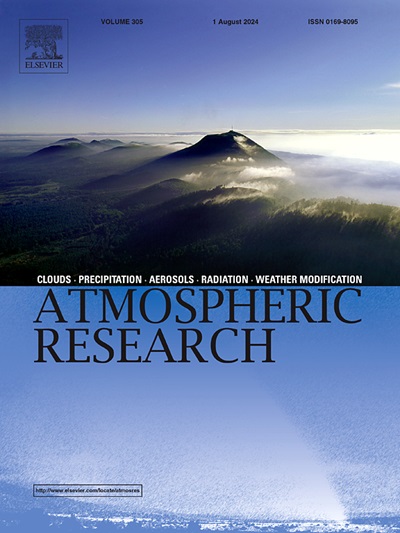Evaluating thunderstorm characteristics and air quality during the COVID-19 lockdown in Northeastern and Eastern India
IF 4.5
2区 地球科学
Q1 METEOROLOGY & ATMOSPHERIC SCIENCES
引用次数: 0
Abstract
The impacts of the COVID-19 lockdown on thunderstorm properties, influenced by changes in air quality, were investigated in Northeastern (Kohima, 25.66° N, 94.08° E) and Eastern (Rampurhat, 24.17° N, 87.78° E) India using seven years of ground-based observations. During the lockdown period (LP), Cloud-to-ground (CG) flashes decreased by 67 % and 51 % over Kohima and Rampurhat respectively. Reductions were noted in the number of thunderstorms and various intensity parameters such as duration, flashes per thunderstorm, Peak Flash Rate (PFR), IC: CG ratio, and lightning peak currents. Significant changes in anthropogenic aerosols were observed, with notable reductions in SO₂, NO₂, and PM₁₀ levels. Regardless of the specific raindrop formation mechanism in the two regions, higher concentrations of moderate to larger raindrops were observed during LP. Also, the mixed-phase region of thunderstorms shows a reduction in water content (both liquid and ice) in the mixed phase and the total column. Daily-scale analysis reveals non-linear associations between pollutant concentrations and CG flashes in both regions, with relative humidity (RH) potentially influencing these relationships. Overall, thunderstorm intensity parameters, mixed-phase processes, and rain DSDs were associated with reduced pollutant concentrations during LP. The similarity of trends in multiple parameters during PLP-LP-ALP aligns with established facts, affirming that reduced pollutants lead to noticeable changes in thunderstorm characteristics. The partial rebound of pollutants and other parameters during ALP remained below pre-lockdown levels, which might suggest the lasting impacts of reduced human activities on atmospheric conditions. Further research is necessary to confirm if these measures could mitigate climatic changes and potentially guide policymakers in addressing such changes.

利用七年的地面观测数据,研究了 COVID-19 封锁对印度东北部(科希马,北纬 25.66°,东经 94.08°)和东部(兰普尔哈特,北纬 24.17°,东经 87.78°)雷暴特性的影响,这些影响受到空气质量变化的影响。在封锁期(LP),科希马和兰普哈特上空的云对地(CG)闪烁分别减少了 67% 和 51%。雷暴次数和各种强度参数(如持续时间、每场雷暴的闪电次数、峰值闪电率 (PFR)、IC:CG比率和闪电峰值电流。观测到人为气溶胶发生了显著变化,二氧化硫₂、氮氧化物₂和可吸入颗粒物₁₀的水平明显下降。无论这两个区域的具体雨滴形成机制如何,在低压过程中都观测到了较高浓度的中等至较大雨滴。此外,雷暴的混合相区域显示出混合相和总柱中含水量(包括液态和冰态)的减少。日尺度分析表明,这两个区域的污染物浓度与 CG 闪光之间存在非线性关系,相对湿度(RH)可能会影响这些关系。总体而言,雷暴强度参数、混合相过程和降雨的数据集与 LP 期间污染物浓度的降低有关。PLP-LP-ALP期间多个参数趋势的相似性与既定事实相吻合,证实了污染物的减少会导致雷暴特征的明显变化。ALP 期间污染物和其他参数的部分反弹仍低于封锁前的水平,这可能表明人类活动的减少对大气条件的影响是持久的。有必要开展进一步的研究,以确认这些措施是否能够缓解气候变化,并为政策制定者应对此类变化提供潜在指导。
本文章由计算机程序翻译,如有差异,请以英文原文为准。
求助全文
约1分钟内获得全文
求助全文
来源期刊

Atmospheric Research
地学-气象与大气科学
CiteScore
9.40
自引率
10.90%
发文量
460
审稿时长
47 days
期刊介绍:
The journal publishes scientific papers (research papers, review articles, letters and notes) dealing with the part of the atmosphere where meteorological events occur. Attention is given to all processes extending from the earth surface to the tropopause, but special emphasis continues to be devoted to the physics of clouds, mesoscale meteorology and air pollution, i.e. atmospheric aerosols; microphysical processes; cloud dynamics and thermodynamics; numerical simulation, climatology, climate change and weather modification.
 求助内容:
求助内容: 应助结果提醒方式:
应助结果提醒方式:


